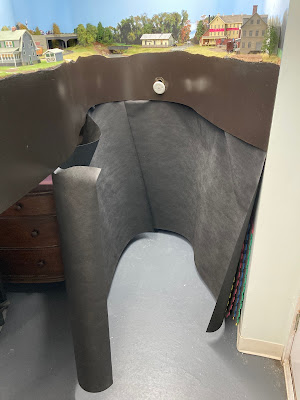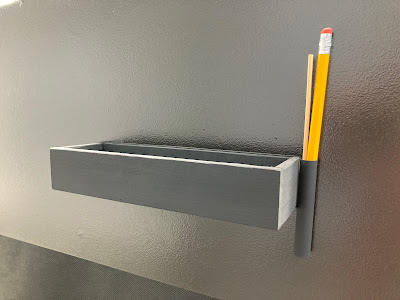The pic above shows the back of the fascia in typical L-girder benchwork construction - specifically, how I attach the fascia to the joists with a 1"x1" cleat. As you may notice, I did not plan well for skirting. If I had, I would have had the cleat end at least 1" short of the bottom of the fascia. That would have provided room for a strip of Velcro to which the skirting could be attached.
Instead of sawing off the bottom end of each cleat (which I considered, BION), I hot-glued clothespins to the back of the cleats. It's important to attach the pins at a uniform height - that'll come in handy later...
In some places, the screw attaching the fascia to the cleat got in the way. Perhaps in a fit of laziness, I decided not to both Dremel-ing off the end of the screw and just glued the pin beside it. You may decide to cut off the screw point - but if you planned ahead better than I did, you probably don't have to use clothespins :^)
Once the pins are installed on each cleat (which, as it happens, are located at the end of every joist and the joists are on about 16" centers), it's time to attach the landscape fabric.
The first such fabric I used (see photos of the Saybrook layout section, as well as New London Staging), was too thin and plastic-y looking. It's ok and will do for now, but I'll probably replace it eventually. The biggest problem was that it was only 3' wide, so it looks too short (my benchwork is at least 48" high).
I later purchased this landscape fabric, primarily because it's available in 4' width. But once I opened it, I discovered two other great qualities: 1) it's much heavier/thicker than what I was using previously and thus hangs much better, and 2) it looks more like cloth than plastic.
Unfortunately, it turned out that 48" was about 6" too wide(!) There was either way too much dragging on the floor, or I had to try and fold it back. At a consistent width. Over 50 linear feet.
I tried cutting it into shorter, more manageable lengths, but then it didn't hang as nice and created unsightly seams.
So I figured I'd "just" cut it down 6" using my chop saw. . .
So far, so good. . .
D'oh!! While it looks a lot like fabric, it's still mostly plastic. Yup - what you see there is melted end from the speed of the saw blade. But at least it's now the right width! And you can still unroll it, with some difficulty. You have to basically tear the one end from the roll as you unroll it. Not too difficult, but it would be SO much nicer if these rolls came in 42" width . .
At this point, all I had to do was start at one end, put the top (ragged/melted) edge into the clothespin - right up to the spring on every one, so the fabric stays at a uniform height - and move on to the next 'pin.
There are some places where the 'pin can't be right on the cleat and the fabric has to go around the end of a joist or splice in the fascia. At those point, you will see a little gapping/bunching, as in the photo above, but it doesn't bother me at the moment and if it ever does, I'll notch the fabric at that point so it tucks up more nicely.
By the way, the photo doesn't render color all that great. The green is actually a bit darker, Pullman green, and the wood boxes are actually painted flat black.
I use inexpensive $1 wood boxes for switchlists, waybills, and other paperwork. I also hot-glue plastic tubes to the side to hold pencils and uncoupling picks (bamboo skewers). These particular boxes are deep enough to allow you to rest of can of soda or a cup of coffee on them.
I'd originally envisioned these boxes as inexpensive throttle holders - and they work ok for that for smaller throttles, but certainly not my NCE hammerhead throttle or <gasp!> ProtoThrottle. So I instead use them as bill boxes in places where aisle width is at a premium - like here at the end of the Berlin Branch. By the way, speaking of inexpensive work-arounds, that's a regular phone jack repurposed as a throttle jack (which you can do with an NCE cab bus, provided it's at the end of the bus run).
I'm pretty happy with how the landscape fabric is working out. I have it just a couple inches off the floor, it hangs nicely and really finishes off the bottom of the layout. And the price is right too.
But I'll withhold my final, final verdict until I encounter my first seam. I think I'm going to use either double-sided tape or Velcro to join the ends evenly. And with so few seams, I'm not sure what kind of easy access I'm going to have to the area underneath the layout. Maybe it'll keep me from putting too much under there. Heh - or maybe just the opposite. It'll be a great place to hide stuff too. . .
So whattyathink? Leave your thoughts and feedback in the comments!














Congrats on going with what you wanted. Including my advice you had a lot of them advice on your Facebook postings. I keep basically just empty rubber maid bins under the layout and a couple suitcases. My fabric pulls up easily but if yours does not cut a slit in the fabric and close it up with a Velcro strip. Overall it looks great. Well done
ReplyDeleteThanks Tom!! (just saw your separate email that this is you :^) Yeah, as wonderful as it is to get the feedback/guidance/opinions (at it is, truly), it CAN get a bit overwhelming too. But I consider that a good problem to have - at least it shows folks are interested! Good tip about cutting a slit - though I may have *just* enough seams to do the same thing :^) Thanks again for taking the time to comment and for following along with my progress!
DeleteThanks for sharing your progress as wll as your techniques, missteps and all.
ReplyDeleteThanks Ken! Hope it's helpful to someone :^)
DeleteLooks great, Chris. Most drapery I've seen has pleats and therefore visible folds. Your solution makes it >look< more solid below the fascia. BTW, the Pullman green was and is the Right Answer . . . to my surprise. I didn't think it would be. Shows what I know . ...
ReplyDeleteThanks - yeah, you know how much I agonized over the color/sheen but while it's just a little shinier than I'd expected, it's not bad - and yeah, I think the color is right. And I also like the "solidness" of the straight fabric - I think pleating is a bit distracting. Thanks for taking the time to leave a comment!
Delete